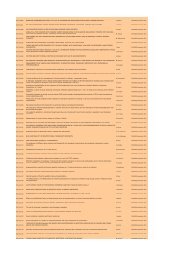Profilaksa DVT kod velikih ortopedskih operacija - Depol ...
Profilaksa DVT kod velikih ortopedskih operacija - Depol ...
Profilaksa DVT kod velikih ortopedskih operacija - Depol ...
Create successful ePaper yourself
Turn your PDF publications into a flip-book with our unique Google optimized e-Paper software.
92<br />
2 st INTERNATIONAL CONFERENCE ON REGENERATIVE ORTHOPAEDICS<br />
CELLULAR AND MOLECULAR ARCHITECTURE OF TENDON AND<br />
LIGAMENT<br />
Andrea Wagner, Paracelsus Medical Universtiy Salzburg, Tendon and Bone Regeneration, Salzburg,<br />
Austria<br />
Renate Gehwolf, Paracelsus Medical Universtiy Salzburg, Tendon and Bone Regeneration, Salzburg,<br />
Austria<br />
Corinna Hirzinger, Universtiy Hospital Salzburg, Traumatology and Sports Injuries, Salzbug, Austria<br />
Milan Toljan, Sportmed Institute, Linz, Austria<br />
Herbert Resch , Universtiy Hospital Salzburg, Traumatology and Sports Injuries, Salzbug, Austria<br />
Hans-Cjristian Bauer, Paracelsus Medical Universtiy Salzburg, Salzburg, Austria<br />
Tendons and ligaments are both dense connective tissues which resemble each other in many aspects but exert<br />
different functions. While the cellular constituents of tendon tissue including tendon progenitor cells have been<br />
well characterized, less information for ligament cells or progenitor cells in ligaments is available. We explore similarities<br />
and differences between tendon and ligament cells at a molecular and biochemical level. Therefore we<br />
used biopsy tissue of semitendinosus tendon (ST) and anterior cruciate ligament (ACL) since ruptured ACL often<br />
is reconstructed by autologous ST grafts.<br />
The expression of progenitor cell markers (Nestin, CD133, Scleraxis) in ACL and ST was analysed by immunhistochemistry<br />
and quantitative RT-PCR. Our analyses revealed differences in the expression levels and expression patterns<br />
of these marker molecules. We also determined the expression of extracellular matrix components (Collagen<br />
type 1, Collagen type 3 and Aggrecan), matrix remodelling proteins (MMP-2, MMP-9, Lysyl oxidase) and Substance<br />
P, a neurotransmitter in pain perception. The mRNA expression of Collagen type 1 and type 3, MMP-2 and Lysyl<br />
oxidase was significantly higher in ACL than in ST. Substance P was only detectable in ACL, Scleraxis and Nestin<br />
showed no differences. The ratio of Collagen type 1 to type 3 mRNA was significantly higher in ACL.<br />
Our results may contribute to the understanding of tendon and ligament nature and origin, and will provide a clue<br />
towards new therapeutic ways in ligament regeneration or reconstruction.<br />
Supported: PMU-FFF E-09/09/051-BAH & ABT GmbH




